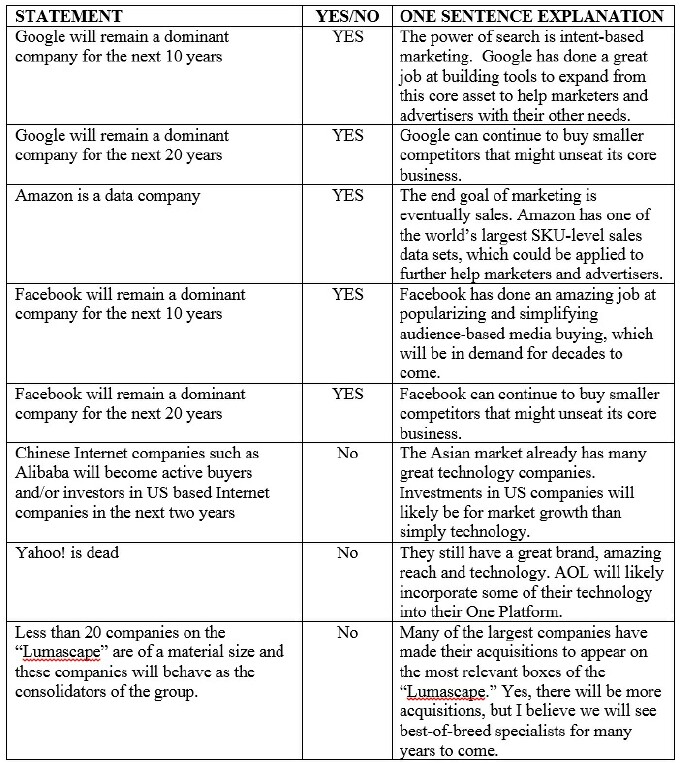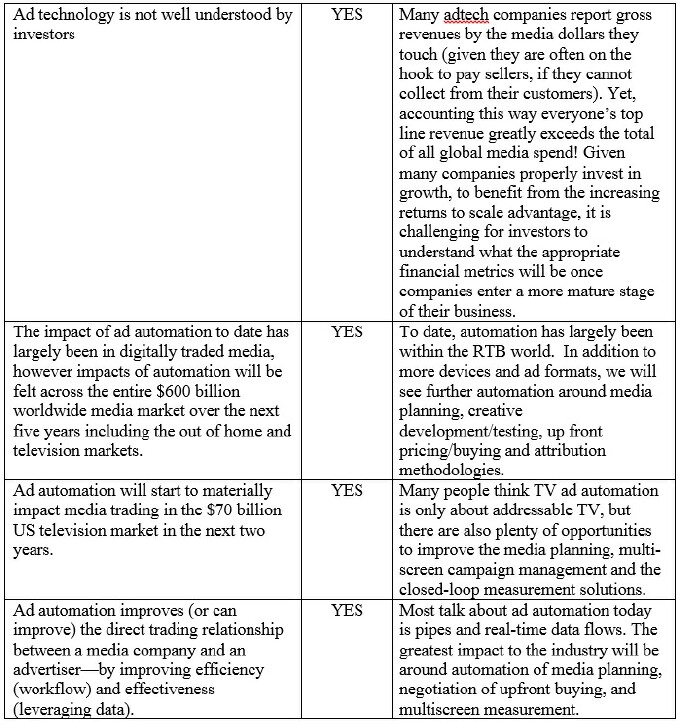Joshua Koran on Issues Affecting Advertisers and Media Owners

As part of his ongoing series of conversations with the leading confidantes and consultants in the ad automation and programmatic area, Jay Sears, Senior Vice President of Rubicon Project, discusses trends and issues of the day impacting advertisers and media owners. In this interview, he talks with Joshua Koran, CEO of Koran Consulting.
Prior to his consulting practice, Koran served as Senior Vice President of Product Management at Turn, where he drove the vision and roadmap for the demand side and data management platform. Prior to joining Turn, Joshua held executive roles at AT&T AdWorks, where he launched the industry's first three-screen audience platform, and at Conversant, where he launched the company's behavioral targeting platform. He previously led product management and engineering at Yahoo!, where he designed and patented Yahoo!'s behavioral targeting platform.
JAY SEARS: What do you read to keep up with politics, art and culture?
JOSHUA KORAN: I usually rely on Google News, The Economist, NPR and The Daily Show for general news.
SEARS: What do you read to keep up with friends?
KORAN:LinkedIn is my go-to source for keeping up with friends and colleagues.
SEARS: What do you read to keep up with the advertising technology industry?
KORAN:AdWeek, AdExchanger, MediaPost, IAB and IAPP are great sources for keeping up on the current buzz. However, given how our industry is structured the POV of the authors has a huge influence on the content and perspectives you'll find.
SEARS: What’s your favorite commercial of all time?
KORAN: I'm definitely dating myself, but I loved the Joe Isuzu ads from the 1980s. The humorous poke at the standard pitch for automobiles stated outrageous claims with onscreen text with the truth. For those who have never seen it, think a precursor to The Wørd segment on The Colbert Report. The humor made it so memorable I'm mentioning it 20 years later!
SEARS: With regards to advertising automation, what are the three biggest trends you expect to impact companies in 2016?
KORAN:
- Further consolidation of media spend among top industry players
- Sellers will adopt techniques that curtail ad blocking (e.g., pop up information, pay walls and ad-block defeating technologies)
- Buyers will increase the use of centralized audience data, both first- and third-party, in their pre-campaign media planning
SEARS: With regards to advertising automation, what are the three most overblown topics that you wish would just go away?
KORAN:
- “Header bidding” is a decade-plus throwback to the old client-side “daisy chain” redirects of ad networks. We moved to server-side auctions to help sellers reduce latency and improve yield, which secondarily helped buyers improve ROI (e.g., by improving frequency caps and increased use of audience data). A simple enhancement to publisher ad servers to give publishers enhanced control over their yield management would eliminate the need for this workaround, which today unfortunately will yield higher revenues, albeit in exchange for increased page load latency.
- “Guaranteed viewability” is another topic that I wish there was more education around. Viewability does matter for branding campaigns. However, the effectiveness of these campaigns should also be measured on other brand lift metrics, such as awareness, recall, brand favorability and purchase intent. For direct response campaigns, viewability is merely an intermediate metric that is already taken into account by the click or conversion performance of the ad slot placement (e.g., if 10% of people scroll to the bottom to see an ad, and 50% of those people click, the ad slot has a horrible viewability metric but great click rate). When media buyers make up front deals, they absorb the risk the sellers will serve their ad in non-viewable locations. This risk is greatly reduced with real-time bidding, where programmatic automation helps factor this into the price buyers pay on a per-impression (rather than per-publisher) basis. Viewability has its place, but the industry still needs more education on improving its understanding of the how and when to use it, as well as how it impacts their overall return on media spend.
- The merger of “adtech” with “martech” is another poorly understood topic. Although the terms “advertising” and “marketing” are often used interchangeably in our ecosystem, the former is a subset of the latter. One of the cleanest divides between advertising and other marketing tactics is whether the campaign uses personal information identifiers (e.g., mailing address, e-mail, telephone number) or anonymous identifiers (e.g., cookies and mobile IDs). Current industry self-regulations require affirmative opt-in consent of consumers to allow companies to bi-directionally merge someone's personal identity with their online activity across multiple websites. There are legitimate one-way transfers of information that start offline (i.e. with PII information) and are on-boarded to anonymous IDs for use across multiple websites, as well as large publishers that acquire opt-in consent of their visitors for this merger on their own properties. However, the industry needs more education on the balance of individuals’ privacy interests tied to their PII with the enhanced targeting and measurement capabilities that bridging these two different types of data can enable. This education is not only for traditional digital devices (desktop and mobile) but also for in-store beacons, payment transactions, map directions and digital video on TVs.
SEARS: The majority of ad technology companies have struggled (relatively small, unprofitable or both). Of the poor performers, what are the commonalities between them that have contributed to this weakness?
KORAN: The most common problem of struggling, smaller companies is that they focus on growth regardless of future profitability. Oftentimes companies will give discounts to customers for large volume deals. Yet if the company does not properly understand its own cost structure with this volume, in terms of data processing, storage and support costs these deals may end up suffocating from the company with its own success. Since there are cost-step functions when scaling a business both on the technology and people side, this is a challenging problem even for experienced entrepreneurs.
Another common problem is knowing what economists call “the boundary of the firm,” namely what services and solutions a company will provide itself vs allow other market players to supply. Since we operate in an extremely complex ecosystem, customers often want the simplicity of a solution that may entail using half a dozen different technologies. For smaller, growing companies, trying to vertically integrate and offer all parts of the solution may not be as successful as focusing on particular subsets the company can profitably provide at scale. Larger companies that have either vertically integrated or have enough support staff to stitch together manually the end-to-end solution provides them a competitive advantage over their smaller rivals. Of course, economists have a term for this, too: an “increasing returns to scale.”
SEARS: A smaller handful of ad technology companies has achieved scale and performed better than the rest. What are the commonalities between them that have contributed to this relative strength?
KORAN:I think there are two key factors behind these successful companies. One of the commonalities among the most successful companies in the adtech space is that they properly understand the economics of their business and focus on profitable growth. Growth can come from geographic expansion, product line extension or targeting new customer segments. Yet each of these strategies has cost implications that nearly always mean a negative hit to margin in the short run. As the company expands, it is critical to properly track the company's KPIs to ensure that the bet the company is making is paying off.
Another commonality is a positive company culture. The world is uncertain and oftentimes the original assumptions behind a strategy need to be adjusted. Often they have both a transparent culture that can acknowledge the need to alter their assumptions, as well as the interdepartmental collaboration required to effectively operate. Clearly these companies will out-compete their less data-driven rivals, which hide bad news and point fingers rather than solving and resolving issues.
SEARS: Do we live in a “tale of two cities” where Google and Facebook win almost everything, advertisers are dictated to and other media companies fight for the scraps?
KORAN: There is no denying the market power of Google and Facebook, nor Verizon, Comcast and AT&T/Dish for that matter. One of the reasons for their increasing success is the increasing returns to scale advantage I mentioned earlier. However, I am optimistic that marketers will want technology solutions that operate across each of the walled and open gardens in our increasingly automated world. Improved attribution methodologies, forecasting and tracking the ROI metrics on Upfront contracts as well as easier and cheaper access to data will help marketers improve the effectiveness and efficiency of their media spend.
SEARS: Please answer the following statements yes or no.
KORAN:


SEARS: If you could go to the airport right now with friends or family and fly anywhere in the world for vacation, who would you take and where would you go?
KORAN:I would take my family to Italy. They love kids and my kids love pasta and pizza.
SEARS: If you could create an endowment to fund any existing non-profit you designated, what lucky non-profit organization would that be?
KORAN: Given a family condition, I would support the Congenital Hyperinsulinism Center run out of the Children's Hospital of Philadelphia.
SEARS: What is your favorite restaurant in the world?
KORAN: I don't have a single favorite. Among the top of my list is the Chinesischer Turm Biergarten in the Englischer Garten (English Garden) in Munich.
SEARS: Thanks, Joshua!
Click the social buttons above or below to share this content with your friends and colleagues.
The opinions and points of view expressed in this article are exclusively the views of the author and/or subject(s) and do not necessarily represent the views of MediaVillage.com/MyersBizNet, Inc. management or associated bloggers.


